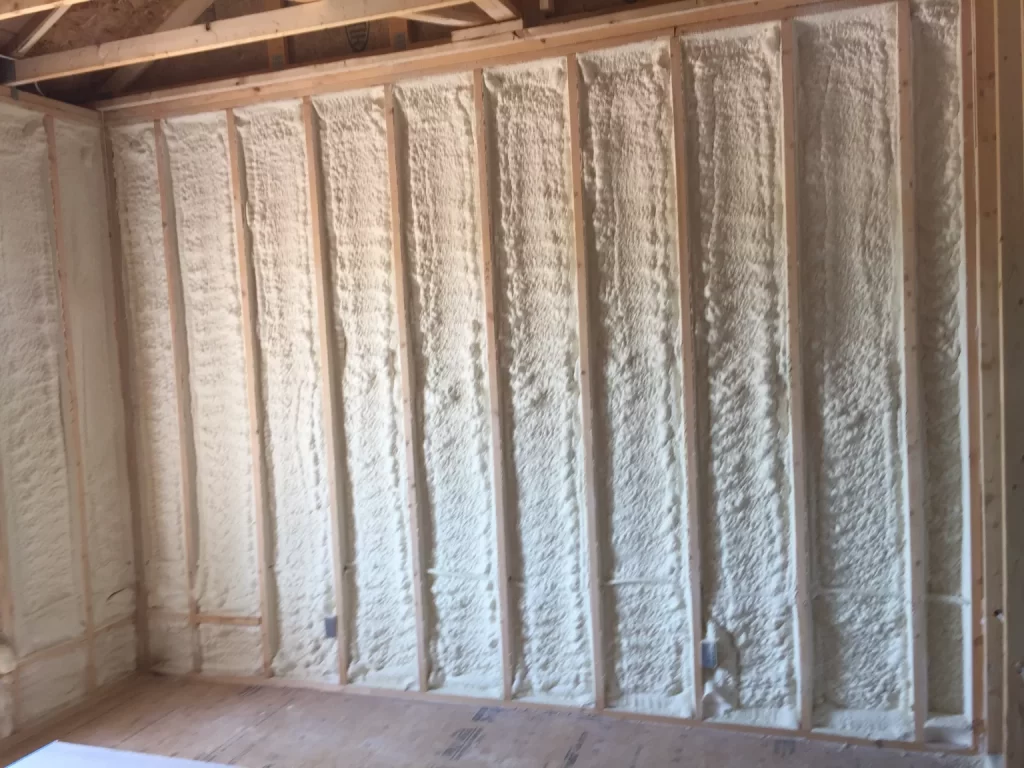Closed-cell spray foam creates an exceptional moisture barrier for Wichita homes by forming a seamless, impermeable membrane with a vapor permeance rating under 1.0 perm. This high-density insulation completely seals building cavities against water infiltration while preventing condensation on interior surfaces, effectively addressing both bulk water intrusion and vapor diffusion—the two primary moisture transport mechanisms affecting Kansas homes. The material’s hydrophobic properties and rigid cell structure resist water absorption and prevent the mold, mildew, and structural damage commonly associated with moisture problems in Wichita’s variable climate.
The comprehensive protection offered by closed-cell foam extends beyond basic moisture resistance to include air infiltration prevention, thermal performance enhancement, and structural reinforcement. These combined benefits make it particularly valuable for Wichita homes facing the region’s frequent humidity fluctuations, seasonal storms, and temperature extremes.
Moisture Challenges for Wichita Homes
Wichita’s climate presents specific moisture challenges for local homes, with annual precipitation averaging 34.3 inches and relative humidity frequently exceeding 65% during summer months. This combination creates persistent moisture pressure on building envelopes throughout the year.
Residential structures in Kansas face multiple moisture entry pathways:
- Foundation seepage during heavy rainfall events
- Vapor diffusion through porous building materials
- Air leakage carrying humidity into wall cavities
- Condensation on thermal bridges during temperature extremes
- Plumbing leaks and interior moisture generation
According to building science research, uncontrolled moisture in residential structures can reduce insulation effectiveness by up to 40% while creating conditions for structural deterioration and indoor air quality problems (Source: Building Science Corporation, 2024).

Comparing Moisture Control Solutions
| Solution | Water Resistance | Vapor Permeance | Air Barrier | Thermal Performance | Structural Benefits | Expected Lifespan |
| Closed-Cell Foam | Excellent | 0.8-1.0 perms (Class II vapor retarder) | Complete air barrier | R-6.5 to R-7 per inch | Yes – adds 25-30% structural rigidity | 30+ years |
| Open-Cell Foam | Good | 5-20 perms (vapor permeable) | Complete air barrier | R-3.7 to R-4.3 per inch | Minimal | 20+ years |
| Fiberglass Batts | Poor | Vapor permeable (requires separate vapor barrier) | None | R-2.9 to R-3.8 per inch | None | 10-15 years |
| Rigid Foam Board | Good to Excellent | 0.5-8.0 perms (varies by type) | Requires sealing at joints | R-3.8 to R-6.5 per inch | Minimal | 20-25 years |
| Traditional Waterproofing | Good for bulk water | No vapor control | No air sealing | No thermal benefit | None | 10-15 years |
How Closed-Cell Foam Addresses Moisture Problems
Closed-cell spray foam provides best insulation moisture protection through multiple mechanisms that work together to create a resilient building envelope. Understanding these mechanisms helps explain why this solution is particularly effective for Wichita’s challenging climate conditions.
Technical Properties of Closed-Cell Foam
| Property | Specification | Benefit | Industry Standard |
| Density | 1.75-2.2 lb/ft³ | Higher density creates tighter cell structure | Min. 1.7 lb/ft³ for moisture resistance |
| Water Absorption | <2% by volume | Minimal water uptake prevents material degradation | <4% for moisture-resistant materials |
| Vapor Permeance | 0.8-1.0 perms at 2″ thickness | Functions as Class II vapor retarder | <1.0 perm for effective vapor control |
| Air Permeance | <0.004 L/s/m² at 1″ | Prevents air-transported moisture | <0.02 L/s/m² code requirement |
| Compressive Strength | 25-30 psi | Resists physical damage and maintains seal | >15 psi for structural applications |
| Closed Cell Content | >90% | Creates moisture-impermeable barrier | >90% for moisture control applications |
| R-Value | 6.5-7 per inch | Prevents condensation by eliminating thermal bridging | Minimum R-5 per inch |
Basement and Foundation Protection
Basements and foundations represent particularly vulnerable areas for moisture intrusion in Wichita homes. The region’s clay-heavy soils retain moisture against foundation walls, creating persistent hydrostatic pressure that can drive water through concrete and masonry materials.
Closed-cell foam applied to basement walls creates a continuous waterproof barrier that bridges cracks and penetrations while preventing capillary water movement through porous concrete. Unlike traditional waterproofing membranes that can separate from the foundation over time, spray foam adheres permanently to the substrate, maintaining protection throughout the structure’s lifetime.
Bonus Tip: When applying closed-cell foam to Wichita basement walls, ensure coverage extends from the sill plate down to the footing to prevent moisture migration at the critical wall-floor junction—a common entry point often overlooked by traditional waterproofing approaches.
Crawl Space Moisture Management
Crawl spaces present unique moisture challenges in Wichita homes, often serving as collection points for ground moisture and humid air. Unconditioned crawl spaces can experience relative humidity levels exceeding 80% during summer months, creating ideal conditions for mold growth, wood rot, and insect infestation.
Closed-cell foam applied to crawl space walls effectively converts these problematic areas into semi-conditioned spaces with controlled moisture levels. The complete air and vapor barrier prevents ground moisture from entering while also blocking humid outdoor air infiltration during summer months.
According to field studies in similar climate zones, properly encapsulated crawl spaces with closed-cell foam insulation maintain average relative humidity levels below 60% year-round, well below the 70% threshold where microbiological growth becomes problematic (Source: Advanced Energy, 2024).
Attic and Roof Assembly Protection
Wichita homes face significant moisture challenges in roof assemblies and attics due to the region’s temperature extremes. Winter conditions can create severe condensation problems when warm interior air contacts cold roof sheathing, while summer humidity can become trapped in poorly ventilated attic spaces.
Closed-cell foam applied directly to roof decking creates an unvented, conditioned attic that eliminates condensation potential while providing exceptional protection against wind-driven rain during severe weather events. This approach is particularly valuable for homes with complex roof geometries or those housing HVAC equipment in attic spaces.
Bonus Tip: For Wichita homes with cathedral ceilings or minimal attic space, closed-cell foam at 2 inches thickness applied directly to the underside of roof decking eliminates the need for soffit and ridge venting while providing superior moisture control compared to traditional insulation methods.
Things to Consider Before Making a Decision
When evaluating closed-cell foam for moisture protection in your Wichita home, several important factors should guide your decision:
- Current Moisture Issues: Existing moisture problems should be identified and addressed before insulation. Closed-cell foam can prevent future moisture intrusion but is not designed to manage active water leaks.
- Building Age and Construction: Older Wichita homes may have different moisture management needs than newer construction. The original building design and ventilation strategy should inform foam application decisions.
- Project Budget and Long-Term Value: While closed-cell foam typically costs 2-3 times more than traditional insulation methods, the combined moisture protection, energy savings, and structural benefits often deliver superior long-term value.
- Interior Living Space Requirements: Closed-cell foam application requires temporary evacuation during installation and curing periods, typically 24-48 hours depending on project scope.
- Future Renovation Plans: Consider how foam insulation might impact potential future renovations, as its permanent adhesion makes future access to insulated cavities more challenging.
Common Questions About Closed-Cell Foam
How does moisture affect Wichita homes?
Moisture problems in Wichita homes can manifest as visible water intrusion, high indoor humidity, condensation on windows and surfaces, musty odors, or mold growth. Left unaddressed, these issues can lead to structural damage, reduced insulation effectiveness, and potential health concerns.
Does closed-cell foam eliminate the need for exterior waterproofing?
For below-grade applications, closed-cell foam works best as part of a comprehensive moisture management system. While it provides excellent secondary moisture protection, proper exterior drainage and waterproofing remain important for optimal moisture management in Wichita’s clay soils.
How quickly can closed-cell foam resolve existing moisture issues?
Closed-cell foam prevents future moisture intrusion but cannot remove existing moisture trapped in building materials. Complete drying of previously wet materials may be necessary before application, and dehumidification may be required to remove residual moisture after foam installation.
Frequently Asked Questions
How does closed-cell foam perform in Wichita’s freeze-thaw cycles?
Closed-cell foam maintains its moisture resistance and insulating properties throughout Kansas temperature extremes. Its stable cell structure resists expansion and contraction damage, while its high R-value helps prevent condensation during rapid temperature changes common in Wichita’s transitional seasons.
Can closed-cell foam be used in all areas of a home?
While exceptionally effective for moisture protection, closed-cell foam may not be necessary or cost-effective for all applications. Areas with minimal moisture exposure or where sound dampening is prioritized might benefit from alternative insulation strategies, though moisture-prone areas like basements, crawl spaces, and exterior walls gain significant protection from closed-cell applications.
How does closed-cell foam impact indoor air quality?
Properly installed and cured closed-cell foam contributes to improved indoor air quality by preventing the infiltration of outdoor allergens and pollutants while controlling indoor humidity levels. By maintaining relative humidity between 30-50%, foam insulation creates conditions unfavorable for dust mites, mold spores, and other airborne irritants common in Wichita homes.
What maintenance does closed-cell foam require?
Once installed, closed-cell foam requires no maintenance to maintain its moisture protection properties. Unlike traditional moisture barriers that may need inspection and repair over time, the seamless application and durable composition of closed-cell foam provide continuous protection for the life of the structure without intervention.
How does closed-cell foam compare to traditional moisture barriers?
Unlike sheet or liquid-applied moisture barriers that can tear, separate from substrates, or create condensation traps when improperly installed, closed-cell foam provides integrated moisture, thermal, and air barrier protection in a single application. This comprehensive approach eliminates the risks associated with incompatible or improperly sequenced multiple-component systems often used in traditional construction.
Secure Your Wichita Home Against Moisture
Closed-cell spray foam provides Wichita homeowners with a comprehensive solution to the region’s specific moisture challenges. The material’s exceptional water resistance, vapor control properties, and air-sealing capabilities work together to create buildings that remain dry, comfortable, and durable despite Kansas climate extremes.
Beyond moisture protection, closed-cell foam delivers significant energy efficiency improvements and structural reinforcement that enhance overall home performance and longevity. These combined benefits make it an effective long-term investment in residential property protection.
For personalized guidance on addressing your home’s specific moisture concerns, contact Arma Coatings of Wichita at (316) 779-2430 or [email protected].
Reviewer:
Charlotte King reviewed this article based on her 7 years of spray foam experience, contributing thoughtful advice about building customer relationships and improving local visibility.







